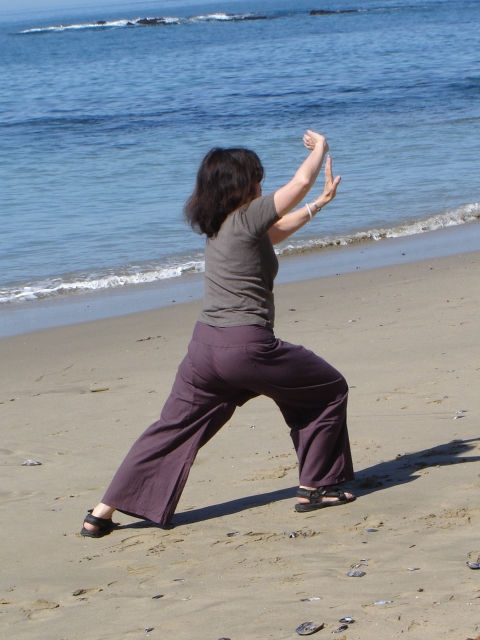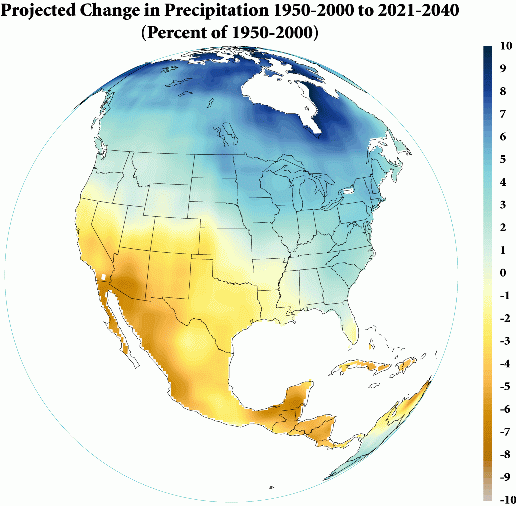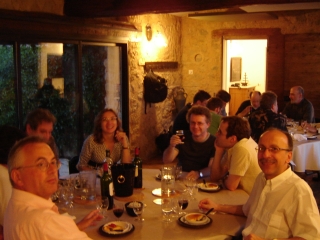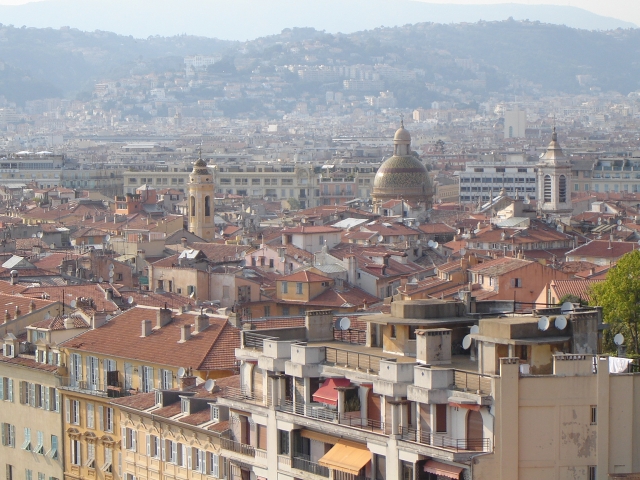

April 2, 2007
Yay! The Supreme Court of the United States ruled that the
Environmental Protection Agency has
the authority to regulate carbon dioxide emissions! It was a
dangerously close ruling, 5-4, with all the conservatives (Alito,
Roberts, Scalia and Thomas) voting against the majority.
April 6, 2007
I've been talking about drought ever since lots of my garden died
after a month of over-100-Fahrenheit weather last summer while I was
in China. On February
28th, I wrote about ancient desert dwellers of the Southwest, and
their mysterious disappearance. On March 9th, I mentioned Brian Fagan's
talk on how global warming causes droughts. And on March 13th, I noted that this year
is the driest on record here in Southern California.
Somehow the local problem makes the global problem more vivid. Of course, one can't blame a specific year's drought on an overall climate shift — and last winter it was very rainy. But, when you're hoping for rain and keep seeing promising clouds drift by without giving a drop, headlines like this make a bigger impression:
Permanent Drought Predicted for Southwest
Alan Zarembo and Bettina Boxall
Los Angeles Times Staff Writers
April 6, 2007
The driest periods of the last century — the Dust Bowl of the 1930s and the droughts of the 1950s — may become the norm in the Southwest United States within decades because of global warming, according to a study released Thursday.
The research suggests that the transformation may already be underway. Much of the region has been in a severe drought since 2000, which the study's analysis of computer climate models shows as the beginning of a long dry period.
The study, published online in the journal Science, predicted a permanent drought by 2050 throughout the Southwest — one of the fastest-growing regions in the nation.
The data tell "a story which is pretty darn scary and very strong," said Jonathan Overpeck, a climate researcher at the University of Arizona who was not involved in the study.
Richard Seager, a research scientist at Lamont-Doherty Earth Observatory at Columbia University and the lead author of the study, said the changes would force an adjustment to the social and economic order from Colorado to California.
"There are going to be some tough decisions on how to allocate water," he said. "Is it going to be the cities, or is it going to be agriculture?"
Seager said the projections, based on 19 computer models, showed a surprising level of agreement. "There is only one model that does not have a drying trend," he said.
Philip Mote, an atmospheric scientist at the University of Washington who was not involved in the study, added, "There is a convergence of the models that is very strong and very worrisome."
The future effect of global warming is the subject of a United Nations report to be released today in Brussels, the second of four installments being unveiled this year.
The first report from the Intergovernmental Panel on Climate Change was released in February. It declared that global warming had become a "runaway train" and that human activities were "very likely" to blame.
The landmark report helped shift the long and rancorous political debate over climate change from whether man-made warming was real to what could be done about it.
The mechanics and patterns of drought in the Southwest have been the focus of increased scrutiny in recent years.
During the last period of significant, prolonged drought — the Medieval Climate Optimum from about the years 900 to 1300 — the region experienced dry periods that lasted as long as 20 years, scientists say.
Drought research has largely focused on the workings of air currents that arise from variations in sea-surface temperature in the Pacific Ocean known as El Niño and La Niña.
The most significant in terms of drought is La Niña. During La Niña years, precipitation belts shift north, parching the Southwest.
The latest study investigated the possibility of a broader, global climatic mechanism that could cause drought. Specifically, they looked at the Hadley cell, one of the planet's most powerful atmospheric circulation patterns, driving weather in the tropics and subtropics.
Within the cell, air rises at the equator, moves toward the poles and descends over the subtropics.
Increasing levels of greenhouse gases, the researchers said, warms the atmosphere, which expands the poleward reach of the Hadley cell. Dry air, which suppresses precipitation, then descends over a wider expanse of the Mediterranean region, the Middle East and North America.
All of those areas would be similarly affected, though the study examined only the effect on North America in a swath reaching from Kansas to California and south into Mexico.
The researchers tested a "middle of the road" scenario of future carbon dioxide emissions to predict rainfall and evaporation. They assumed that emissions would rise until 2050 and then decline. The carbon dioxide concentration in the atmosphere would be 720 parts per million in 2100, compared with about 380 parts per million today.
The computer models, on average, found about a 15% decline in surface moisture — which is calculated by subtracting evaporation from precipitation — from 2021 to 2040, as compared with the average from 1950 to 2000.
A 15% drop led to the conditions that caused the Dust Bowl in the Great Plains and the northern Rockies during the 1930s.
Even without the circulation changes, global warming intensifies existing patterns of vapor transport, causing dry areas to get drier and wet areas to get wetter. When it rains, it is likely to rain harder, but scientists said that was unlikely to make up for losses from a shifting climate.
Kelly Redmond, deputy director of the Western Regional Climate Center in Reno, who was not involved in the study, said he thought the region would still have periodic wet years that were part of the natural climate variation.
But, he added, "In the future we may see fewer such very wet years."
Although the computer models show the drying has already started, they are not accurate enough to know whether the drought is the result of global warming or a natural variation.
"It's really hard to tell," said Connie Woodhouse, a paleoclimatologist at the University of Arizona. "It may well be one of the first events we can attribute to global warming."
The U.S. and southern Europe will be better prepared to deal with frequent drought than most African nations.
For the U.S., the biggest problem would be water shortages. The seven Colorado River Basin states — Colorado, Wyoming, Utah, Nevada, New Mexico, Arizona and California — would battle each other for diminished river flows.
Mexico, which has a share of the Colorado River under a 1944 treaty and has complained of U.S. diversions in the past, would join the struggle.
Inevitably, water would be reallocated from agriculture, which uses most of the West's supply, to urban users, drying up farms. California would come under pressure to build desalination plants on the coast, despite environmental concerns.
"This is a situation that is going to cause water wars," said Kevin Trenberth, a scientist at the National Center for Atmospheric Research in Boulder, Colo.
"If there's not enough water to meet everybody's allocation, how do you divide it up?"
Officials from seven states recently forged an agreement on the current drought, which has left the Colorado River's big reservoirs — Lake Powell and Lake Mead — about half-empty. Without some very wet years, federal water managers say, Lake Mead may never refill.
In the next couple of years, water deliveries may have to be reduced to Arizona and Nevada, whose water rights are second to California.




April 9, 2007
On April 28th of last year I mentioned
how coyotes were moving into American suburubs. Here's another sign
of that: Riverside has a new policy about coyotes.
Sometimes the world gets so weird you can only laugh... here's a headline that didn't actually make the newspapers, but should have:
Next weekend I'm leaving for France, to a workshop on the Philosophical and Formal Foundations of Modern Physics. It's is being held at a country estate called Les Treilles in the Var near Nice, in southern France. It sounds nice:
The estate is situated in a landscape of hills and valleys at an average altitude of 600 m. It includes agricultural plots (vines, olive trees terraced on "restanques", lavender) and spacious areas of natural land with a great variety of local flora and woodland. A network of paths meandering through the property are particularly suited for reflection.Of course, in British English, "torch" means "flashlight". I remember being confused about that, once upon a time. I would wonder, when reading novels, "Why are the British so primitive, carrying around torches like cavemen?". And they ate "pudding" for dessert all the time!The guests' activities are centred around the "Grande Maison" which contains a conference room, the library, the kitchen and the dining area. Broadband Internet access with Wifi is available there.
Guests are lodged in a number of houses spread out over the estate, the closest to the Grande Maison only a couple of minutes away. Cars are available to reach more remote houses (up to two kilometres following the road), but walking remains by far the most agreeable means of transport.
Each house has between one and three rooms with a shower or bathroom, one or two kitchens particularly intended for breakfast. There are telephones, but not yet broadband connections. Each guest will find the necessary household linen and, in accordance with the express wish of the founder, a torch and an umbrella.
I'd been hoping Carlo Rovelli would attend this workshop, but it looks like a student of his is taking his place. It's fun talking about quantum mechanics in the French countryside, but a lot more fun with friends. I'll know Lucien Hardy (a radical physicist and all-around nice guy I met at the Perimeter Institute), and Jeffrey Bub (slightly — he's a well-known philosopher of quantum mechanics whom I briefly met at PI), and Hermann Nicolai (a string theorist and fan of exceptional Lie groups at the Albert Einstein Insitute in Golm), and Rob Spekkens (by name only: he thinks we can observe a quantum superposition of an atom and a molecule). I'll have to get to know them better.
Hmm — maybe I should do something smart and find out what everyone at the conference does before I go to it. What a concept! I'm not naturally very good at people things.
I want to read this book — it got surprisingly good reviews:
Watch out! Greg Egan pointed out that in the director's cut of the movie String Kings I'm being played by the star of the The Sopranos:
To celebrate his release from San Quentin, and as a reprisal for the recent spate of hits, crime math kingpin John Baez — played by James Gandolfini with perm wig and glasses — orders the blowing up of a workshop taking place on non-perturbative aspects of M(afia)-Theory. During a lunch break in the seminars, a wire is noticed protruding from one of the boxes of ordered pizzas and Italian food, about a second before the ensuing explosion takes out the conference. Very good effects and stunt work as some postdoc string theorists are blown back and somersault about 270 degrees before being blown through windows, but basic laws of conservation of momentum and angular momentum do not seem to be being properly obeyed — something one really should expect in a film that deals with theoretical physics at this high level.

I'm enjoying listening to the Grateful Dead's album Blues for Allah. I remember first hearing this in the room of my friend Chip Wendt at 2 Dickinson St., back when us misfits and counterculture sorts at Princeton used that house as a vegetarian cooperative. For years the only two Dead albums I've listened to are Workingman's Dead and American Beauty. Both these are easy-going, soulful, acoustic-sounding, relaxed, yet perfectly crafted. More recently I got Shakedown Street, which is a bit too clean and studio-polished for what I want from the Dead: it's very good, but doesn't have the feeling of a bunch of hippie virtuoso musicians who like to hang out on the front porch jamming. Blues for Allah is different yet again: more jazzy fusion and Middle-Eastern influences, more trippy. It doesn't fit together in the satisfying way that American Beauty and The Workingman's Dead do — maybe it's just too stylistically diverse. But, it's full of cool musical ideas.
I've always like the subtly reggae-inflected song Crazy Fingers. It's fun hearing that again.
Yay! It's raining! Goes well with some of the lyrics from Crazy Fingers:
The participants are staying in small cottages; I'm sharing one with Lucian Hardy. It was so far from the main building that they gave us a car to drive. Each morning we bring in a basket to get our breakfast supplies restocked.
Everybody had lunch and dinner together — excellent French cuisine:

From left to right, the people at the front table are the string theorist Hermann Nicolai, a fellow who'd been staying at Les Treilles to write a book, Patricia Kauark-Leite, Lucien Hardy, Christopher Timpson, and one of the conference organizers, Michel Bitbol.
I wrote about the conference in week250 and week251 of This Week's Finds, but only touched on one aspect - the mathematics of quantum theory. The conference as a whole was much more philosophical, and touched on general relativity as well as quantum theory. I still need to write up some stuff Hermann Nicolai told me about gravity, billiards and Weyl chambers.
The first photo above was taken by Marc Lachièze-Rey. You can see more photos by him here. Here's another: I'm pondering the mysteries of the universe, or at least the mysterious power of coffee to combat jet-lag:
Marc works in the Astroparticule et Cosmologie group at CNRS in Paris. There are a lot of universities in Paris, and I don't understand the whole system, but this group is at Université Paris 7. He's invited me to spend some of July 2008 visiting this group. That sounds great, especially since I'm spending this July in Paris visiting Paul-André Melliès and the PPS (Preuves, Programmes et Systèmes) group of CNRS, also at Paris 7.
Paris is wonderful; I'd like to get to know it better, and
it's nice to have a little continuity in life, so I'm looking
forward to spending time there two summers in a row.
I used to visit Cambridge England quite often, but I haven't
been there for a long time.
April 28, 2007
I spent my last day in France visiting Eugenia Cheng in
Nice, a charming city on the Riviera, less wealthy and decadent
than neighboring Monaco and Cannes:

The narrow streets and tall buildings keep the old part of town cool during the hot Mediterranean summer — even without air conditioning. Smart!


Near the border with Italy, this city has a rich history going back to its days as the Greek colony of Nicaea. I was charmed by some traces of its old language: Nissart, also called Niçard or Niçois. It's a dialect of Occitan.
Never heard of Occitan? It's also called Langue d'Oc — a term that goes back to Dante, who distinguished between the Romance languages that say "oïl" for yes, those that say "si", and those that say "oc". You may have heard of Provençal: that's the biggest dialect of Occitan, and the poetry of its troubadors is famous.
Occitan is spoken througout Occitania, otherwise known as Aquitania:
Nice is on the far eastern end of Occitania. Where France meets Spain, Occitan gives way to Catalan, which is quite similar, but regarded as a separate language.
I wish I knew Portuguese, Spanish, French and Italian, and maybe some Occitan. Then I could hike along the shore of the Mediterrean from Portugal all the way to Trieste, on Itay's border with Slovenia... and the Romance dialects I'd encounter would form a kind of continuum. Reality is richer, messier, more interesting than the system of precise borders we use to demarcate it! That's why I'm fascinated by Nissart — just as I'm fascinated by Nahwá.
You can learn Nissart online if you know French. You can also see a French-Nissart dictionary. But if that's too much work, you can visit a silly website that lists what it claims are "four essential travel phrases" in many languages. These phrases are:
| Latin | Occitan | Catalan | French | Italian | Spanish | Portuguese | Romanian | English |
| cantare | cantar (chantar) | cantar | chanter | cantare | cantar | cantar | cânta | to sing |
| capra | cabra (chabra, craba) | cabra | chèvre | capra | cabra | cabra | capră | goat |
| clavis | clau | clau | clef/clé | chiave | llave | chave | cheie | key |
| ecclesia, basilica | glèisa | església | église | chiesa | iglesia | igreja | biserică | church |
| formaticum (caseus) | formatge (hormatge) | formatge | fromage | formaggio | queso | queijo | caş | cheese |
| lingua | lenga (lengua) | llengua | langue | lingua | lengua | língua | limbă | language |
| nox, noctis | nuèch (nuèit) | nit | nuit | notte | noche | noite | noapte | night |
| platea | plaça | plaça | place | piazza | plaza | praça | piaţă | [city] square |
| pons, pontis | pont (pònt) | pont | pont | ponte | puente | ponte | punte | bridge |
All that I serve will die, all my delights,
the flesh kindled from my flesh, garden and field,
the silent lilies standing in the woods,
the woods, the hill, the whole earth, all
will burn in man's evil, or dwindle
in its own age. Let the world bring on me
the sleep of darkness without stars, so I may know
my little light taken from me into the seed
of the beginning and the end, so I may bow
to mystery, and take my stand on the earth
like a tree in a field, passing without haste
or regret toward what will be, my life
a patient willing descent into the grass.
— Wendell Berry
© 2007 John Baez
baez@math.removethis.ucr.andthis.edu